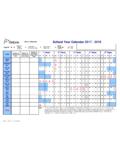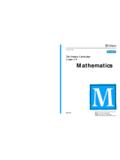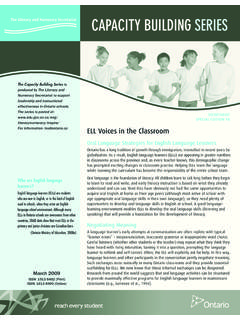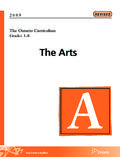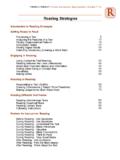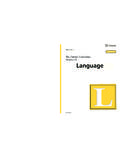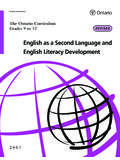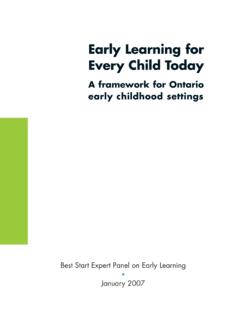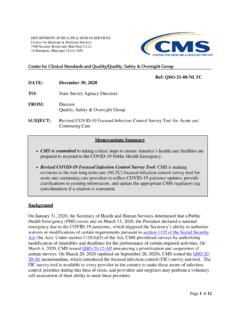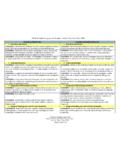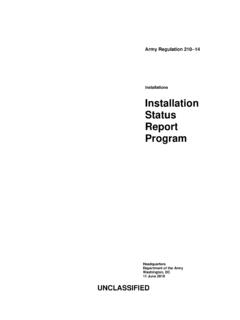Transcription of Growing Success: Assessment, Evaluation and Reporting in ...
1 CONTENTS. Introduction 1. 1. Fundamental Principles 5. 2. Learning Skills and Work Habits in Grades 1 to 12 9. 3. Performance Standards The Achievement Chart 15. 4. Assessment for Learning and as Learning 27. 5. Evaluation 37. 6. Reporting Student Achievement 47. 7. Students With Special Education Needs: Modifications, Accommodations, and Alternative Programs 69. 8. English Language Learners: Modifications and Accommodations 75. 9. E-Learning 79. CONTENTS. 10. Credit Recovery 83. Appendix 1: Large-Scale Assessments 91. Appendix 2: Progress Report Card and Provincial Report Card Templates 97. Appendix 3: Resources for Particular Policy and Program Areas 139. Glossary 143. References 157. Une publication quivalente est disponible en fran ais sous le titre suivant : Faire cro tre le succ s : valuation et communication du rendement des l ves fr quentant les coles de l'Ontario.
2 Premi re dition, 1 re 12 e ann e. 2010. This publication is available on the Ministry of Education's website, at 1. INTRODUCTION. This document supersedes the sections outlining assessment, Evaluation , and Reporting policy in The Ontario Curriculum, Grades 9 to 12: Program Planning and Assessment, 2000 and in curriculum policy documents for Grades 1 to 8, Grades 9 and 10, and Grades 11 and 12 published before the release of this document, with the following exception: The achievement charts in all current curriculum policy documents remain in effect. This document also supersedes the following documents and memoranda: Guide to the Provincial Report Card, Grades 1 8, 1998 (as updated on the ministry website on September 5, 2000). Guide to the Provincial Report Card, Grades 9 12, 1999.
3 Deputy Minister's Memorandum dated September 5, 2000: Changes in Reporting the Strands of Mathematics on the Elementary Report Card . Directors' Memorandum, Curriculum and Assessment Policy Branch and French Language Education Policy and Program Branch, dated May 24, 2006: Revision to Provincial Report Card, Grades 9 12: The Expansion of Eligible Courses Recognized as Compulsory for the OSSD . Acting Director's Memorandum, Curriculum and Assessment Policy Branch, dated June 22, 2006: INTRODUCTION. Release of Revised Grades 1 8, Language, 2006, Curriculum Policy Document . Beginning in September 2010, assessment, Evaluation , and Reporting in Ontario schools will be based on the policies and practices described in this document. The present edition of this document includes all relevant and final information pertaining to Grades 1 to 12.
4 A forthcoming edition, planned for release in 2011, will complete the document, including information pertaining to the curriculum for the new full-day Kindergarten program (planned for release in 2011). The Ontario government is committed to enabling all students to reach their potential, and to succeed. Our challenge is that every student is unique and each must have opportunities to achieve success according to his or her own interests, abilities, and goals. We have defined high expectations and standards for graduation, while introducing a range of options that allow students to learn in ways that suit them best and enable them to earn their diplomas. We are proud that our students regularly place among the world's best on international standardized tests. 2 G R OW I N G S U C C E S S | assessment, Evaluation , and Reporting in Ontario schools The Ministry of Education's assessment, Evaluation , and Reporting policy has evolved significantly over the course of the last decade.
5 Previously, aspects of the policy appeared in a number of documents and were not fully aligned across the elementary and secondary panels. In addition, stakeholders often expressed concerns about unevenness in the way the policies were being implemented among boards and schools. The present document updates, clarifies, coordinates, and consolidates the various aspects of the policy, with the aim of maintaining high standards, improving student learning, and benefiting students, parents,1 and teachers in elementary and secondary schools across the province. The document is intended to ensure that policy is clear, consistent, and well aligned across panels and across school boards and schools, and that every student in the system benefits from the same high-quality process for assessing , evaluating, and Reporting achievement.
6 This document, in its forthcoming final edition, will outline a comprehensive policy for the assessment, Evaluation , and Reporting of student achievement in Ontario schools, from Kindergarten to Grade 12. The policy is based on seven fundamental principles, the first of which tells us that assessment, Evaluation , and Reporting practices and procedures must be fair, transparent, and equitable for all students. At the same time, students and parents need to know that evaluations are based on evidence of student learning and that there is consistency in the way grades are assigned across schools and boards throughout the province. With this knowledge, students can have confidence in the information they use to make decisions about secondary pathways and postsecondary opportunities. INTRODUCTION.
7 The policy outlined in this document is designed to move us closer to fairness, transparency, and equity, as well as consistent practice. Successful implementation of policy depends on the professional judgement of educators at all levels, as well as on educators' ability to work together and to build trust and confidence among parents and students. It depends on the continuing efforts of strong and energized professional learning communities to clarify and share their understanding of policy and to develop and share effective implementation practices. It depends on creative and judicious differentiation in instruction and assessment to meet the needs of all students, and on strong and committed leadership from school and system leaders, who coordinate, support, and guide the work of teachers.
8 Recognizing that the needs and circumstances of individual boards vary widely, the policy outlined in this document provides flexibility for boards to develop some locally focused guidelines and implementation strategies within the parameters for consistency set by the ministry. Education stakeholders throughout the province have voiced the need for greater consistency in assessment, Evaluation , and Reporting practices among the schools within a board, and initiatives to achieve improvement in that regard are strongly encouraged. Board guidelines should always be developed in collaboration with all the schools in the board, and in consultation with the school community. 1. Throughout this document, parents is used to refer to both parents and guardians. INTRODUCTION 3. Policies and procedures for assessment, Evaluation , and Reporting need to develop over time, as we learn more about how students learn.
9 The policies outlined in this document reflect the current state of our evolving knowledge about the learning experience. New approaches to assessment provide both opportunities and challenges to all educators, for the benefit of all students. The Organization of This Document The first chapter of this document lays out the fundamental principles that form the foundation of all policy outlined in the remaining chapters. Chapter 2 focuses on learning skills and work habits. It comes immediately after the discussion of fundamental principles to reflect the importance of these skills and habits, in the view of all education stakeholders in Ontario, for the education and success of our students. Chapter 3 presents policies related to performance standards, as represented in the Achievement Chart and described in current Ontario curriculum policy documents.
10 Chapter 4 represents new understandings and policy related to the role that assessment can play in the improvement of student learning, and clarifies the differences between assessment for learning, assessment as learning, and assessment of learning (or Evaluation ). Chapters 5 through 8 update, clarify, consolidate, and coordinate policies for evaluating and Reporting student achievement. These chapters address key issues such as gathering evidence of INTRODUCTION. student learning; dealing with late and missed assignments; and using the code R and percentage marks below 50 per cent, as well as the code I , in the Evaluation and Reporting of student achievement. They also present guidelines for school boards to develop some of their own policies pertaining to issues such as late and missed assignments and plagiarism, explain the use of the new fall Elementary Progress Report Cards, and discuss policies pertaining to students with special education needs and students who are learning English.
